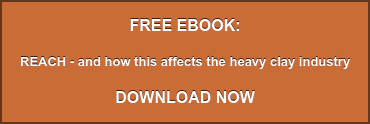
Registration, Evaluation, Authorisation & restriction of CHemicals (REACH) is a regulation that aims to make the handling and commercialisation of chemicals safer. Many industries and markets have had to adapt to this new regulation, and we have identified ways in which REACH can actually bring oportunities to the heavy clay manufacturing sector.
reach and heavy clay manufacturing
The main raw materials used in ceramic production are clays, sands, grogs plus some unique factory specific materials like granite, paper, cellulose, glass etc. Annex V.7 gives you all exemption from REACH Registration as they are classed as naturally occurring in nature or have no hazardous properties/contain no hazardous ingredients.
All brick and tile manufacturers will use some type of chemical –be it brick oil, solvents, cleaning materials through to additives such as body colours, clay conditioners, anti-scumming agents, manganese. These products where applicable will require to be REACH Registered either by the manufacturer, importer or downstream user.
As a producer of articles or specific end user you will not be required to carry out any registration (unless you fail to tell your suppliers how you use their substances or mixtures) however for a chemical importer or manufacturer then full compliance and registration is compulsory.
For your own HSE Management Systems you will require to be supplied with updated SDS. Previously under CHIP suppliers had to provide the SDS at the first delivery for substances classified as dangerous Now REACH has taken over the system SDS have been changed to take in to account CLP Regulations and any update to a SDS must be supplied every time.
what are the oportunities to you under reach
The arrival of REACH should improve worker health and safety by the provision of better information. Furthermore, it should establish new and better channels of communication between employers and suppliers. It will remove substances of very high concern from the market and replace them by less dangerous substances or technologies where suitable economically and technically viable alternatives are available.
REACH does not affect the application of Directives on worker protection and the environment, especially Directive 2004/37/EC (the protection of workers from the risks related to exposure to carcinogens or mutagens at work) and Directive 89/391/EEC) (the protection of the health and safety of workers from the risks related to chemical agents at work) under which employers are required to eliminate dangerous substances, wherever technically possible, or to substitute dangerous substances with less dangerous substances.
REACH also provides for downstream users to pass information back up the supply chain to suppliers and registrants. It may be that a downstream user has a special use for a substance. Downstream users can tell their supplier about this use and request the registrant’s support of that use in a CSA (Chemical Safety Assessment) and CSR (Chemical Safety Report). Actors in the supply chain must pass such a request back up the supply chain. But if the downstream user wants their special use kept secret from suppliers, they have additional duties.
This Regulation is based on the principle that it is for manufacturers, importers and downstream users to ensure that they manufacture, place on the market or use such substances that do not adversely affect human health or the environment.
To ensure workability and to maintain the incentives for waste recycling and recovery, wastes should not be regarded as substances, mixtures or articles within the meaning of this Regulation.
Where a downstream user is not prepared to tell their supplier about their special use, they have to take the responsibility for preparing a CSR themselves, in line with REACH Article 14 (see Annex 1). However, there are many conditions for downstream users to meet and they are likely to seek to avoid this eventuality.
In summary REACH should improve workers health and safety by the provision of better information and should establish new and better channels of communication between employers and suppliers. It is intended to remove substances of very high concern from the market to be replaced by less dangerous substances or technologies where suitable economical and technical alternatives are available.
Do you want to know all about REACH? Download our ebook!





